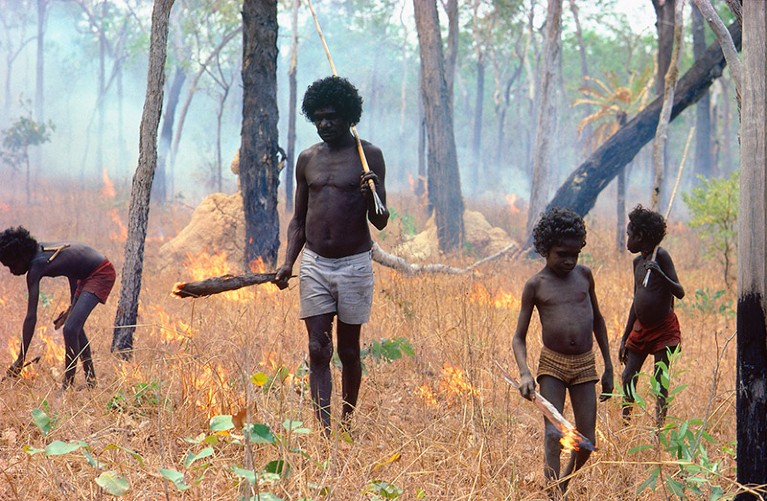

Northern Australian elder George Milpurrurr shows the next generation how to do a cultural burn.Credit: Penny Tweedie/Alamy
Indigenous Australians have been using fire to shape the country’s northern ecosystems for at least 11,000 years, according to charcoal preserved in the sediment of a sinkhole. The study was published on 11 March in Nature Geoscience1.
The practice of cultural burning, also known as ‘fire-stick farming’, is integral to Indigenous Australian culture and history, and is understood to have profoundly altered landscapes across the country.
Fire-stick farming involves introducing frequent, low-intensity fires in small areas of the landscape in a patchy, ‘mosaic’ pattern, and is done early in the dry season. The practice is important culturally and environmentally; in particular, it reduces the amount of fuel available for burning and therefore decreases the intensity of wildfires that might spark late in the dry season because of lightning strikes or other triggers.
Archaeological evidence indicates that humans have continuously occupied the Australian continent for at least 65,000 years2, but little is known about when the practice of fire-stick farming began.
“You need a really long record that goes back before people were here so you can see what the natural world — the definitively unimpacted world, if you’d like — looks like and then you’ve got enough of a record to be able to see if anything changed,” says study co-author Michael Bird, a geologist at James Cook University in Cairns, Australia.
The researchers found that record in the sediment of Girraween Lagoon, a permanent water body formed in a collapsed sinkhole near Darwin in the Northern Territory. The lagoon is an important site for the traditional owners of the land, the Larrakia Nation, and was made famous by the crocodile attack scene in the 1986 film Crocodile Dundee.
Because the lagoon has remained full, its sediments offer a continuous record of deposition that has not been disturbed by drying out and cracking. Bird and his colleagues were able to extract a core from the bottom of the lagoon that provided a 150,000-year-long record of changes in the type and geochemistry of the deposited charcoal, and in the accumulation of pollen.
Change in the charcoal
The team notes that, around 11,000 years ago, the changes in the charcoal deposits point to alterations in the intensity of fires in the area.
Without human influence, fires are less frequent but have enough intensity to burn trees and leave behind charcoal, says Bird.
“A less-intense fire doesn’t get into the crown — it’s burning what’s on the ground,” he says. The grass, as well as twigs and fallen tree leaves, are more likely to become charcoal than the trees themselves, he adds.
Because tree-derived charcoal has higher concentrations of the isotope carbon-13 than does charcoal from grasses, the researchers analysed the composition and geochemistry of the burnt residue in the sample. The authors found a sustained change from low-frequency, high-intensity fires — the ‘natural’ fire regime — to more frequent but less intense ones, which they suggested was the result of Indigenous fire-stick farming.
The authors ruled out climate change as the cause of the shift by using the ratio of tree pollen to grass pollen as a type of climate history to show that vegetation changes did not explain the shift in the charcoal record.
However, Bird notes that European colonization has mostly brought an end to cultural burning practices, and has shifted fire intensity back towards a natural pattern. “Because we’ve had, 10,000 plus years of a particular fire regime, it’s the release from that fire regime that’s actually creating quite significant issues,” he says, suggesting that this shift has contributed to the return of more high-intensity wildfires.
Joe Fontaine, a fire ecologist at Murdoch University in Perth, Australia, says that the growing understanding of how cultural burning has shaped the Australian landscape, particularly in the northern regions, is crucial for contemporary fire-management practices, which to a large extent have excluded Indigenous people and their expertise.
“The barriers to doing cultural burning, in our arcane system of laws and bureaucracy,” are challenging to overcome, Fontaine says. There are also many more permanent structures in the landscape nowadays than there were before colonization, he says, so the challenge is to work out where and how cultural burning can be restored as a practice.
The continuing work that “puts cultural burning practices out there and establishes it as something that really existed, is crucial to the evolution of contemporary fire management,” he says.
Source link




